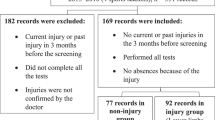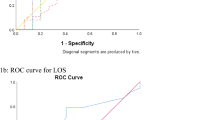Abstract
Purpose
Lower extremity sports injuries are associated with impaired dynamic balance function, and the modified Star Excursion Balance Test (mSEBT) is proposed as a screening tool for lower extremity injuries. This study aimed to clarify the relationship between dynamic balance function and lower limb injury experience among school-age female badminton players.
Methods
Forty-two subjects were included. The mSEBT was used for dynamic balance function evaluation. Furthermore, lower limb joint range of motion, lower limb muscle strength, and foot arch height ratio were measured. Lower limb injury experience within the past year was assessed using a questionnaire. The subjects were divided into the injury and non-injury groups according to lower limb injury experience, and mSEBT and physical function results were compared. Multiple regression analysis was conducted with the mSEBT value as the dependent variable and previous lower limb injury experience as the independent variable, with the knee extension muscle strength, arch height ratio, and age as covariates.
Results
Intergroup comparison showed that the injury group had significantly higher mSEBT and dorsiflexion angle values and lower arch height ratios. No significant differences were found for the other parameters. In the multiple regression analysis, mSEBT had a significant relationship with previous lower limb injury experience.
Conclusions
A high mSEBT score was significantly related to previous lower limb injury experience. Further research is needed to examine this difference, including external factors such as training intensity and frequency, as well as physical function factors.
Similar content being viewed by others
Data availability
This study is not applicable.
Abbreviations
- SEBT:
-
Star excursion balance test
- mSEBT:
-
Modified star excursion balance test
References
Nippon Badminton Association. Registered members. https://www.badminton.or.jp/nba/regist.html. Accessed July 23, 2022.
Low J, Mohamad NI, Ong KB, Aziz SA, Abdullah M, Maliki A (2018) The developmental pathways of Malaysian elite youth badminton players. J Fund Appl Sci 9:842. https://doi.org/10.4314/jfas.v9i2s.60
Liu X, Imai K, Zhou X, Watanabe E (2022) Influence of ankle injury on subsequent ankle, knee, and shoulder injuries in competitive badminton players younger than 13 years. Orthop J Sports Med 10:23259671221097440. https://doi.org/10.1177/23259671221097438
Jørgensen U, Winge S (1987) Epidemiology of badminton injuries. Int J Sports Med 8:379–382. https://doi.org/10.1055/s-2008-1025689
Duart J, Bigoni M, Kocher MS (2023) Pediatric anterior cruciate ligament tears and associated lesions: Epidemiology, diagnostic process, and imaging. J Child Orthop 17:4–11. https://doi.org/10.1177/18632521231153277
Butler RJ, Southers C, Gorman PP, Kiesel KB, Plisky PJ (2012) Differences in soccer players’ dynamic balance across levels of competition. J Athl Train 47:616–620. https://doi.org/10.4085/1062-6050-47.5.14
Plisky PJ, Rauh MJ, Kaminski TW, Underwood FB (2006) Star Excursion Balance Test as a predictor of lower extremity injury in high school basketball players. J Orthop Sports Phys Ther 36:911–919. https://doi.org/10.2519/jospt.2006.2244
Butler RJ, Bullock G, Arnold T, Plisky P, Queen R (2016) Competition-level differences on the lower quarter Y-balance test in baseball players. J Athl Train 51:997–1002. https://doi.org/10.4085/1062-6050-51.12.09
Pandey A, Venugopal R (2016) Comparison of dynamic balance using SEBT between athletes and non-athletes. Int J Phys Educ Sports Health (Online) 3:238–240
Stiffler MR, Sanfilippo JL, Brooks MA, Heiderscheit BC (2015) Star Excursion Balance Test performance varies by sport in healthy division I collegiate athletes. J Orthop Sports Phys Ther 45:772–780. https://doi.org/10.2519/jospt.2015.5777
Gribble PA, Hertel J, Denegar CR, Buckley WE (2004) The effects of fatigue and chronic ankle instability on dynamic postural control. J Athl Train 39:321–329
Hertel J, Braham RA, Hale SA, Olmsted-Kramer LC (2006) Simplifying the star excursion balance test: analyses of subjects with and without chronic ankle instability. J Orthop Sports Phys Ther 36:131–137. https://doi.org/10.2519/jospt.2006.36.3.131
Hertel J (2008) Sensorimotor deficits with ankle sprains and chronic ankle instability. Clin Sports Med 27:353–370. https://doi.org/10.1016/j.csm.2008.03.006
Cote KP, Brunet ME, Gansneder BM, Shultz SJ (2005) Effects of pronated and supinated foot postures on static and dynamic postural stability. J Athl Train 40:41–46
Norris B, Trudelle-Jackson E (2011) Hip- and thigh-muscle activation during the star excursion balance test. J Sport Rehabil 20:428–441. https://doi.org/10.1123/jsr.20.4.428
Hoch MC, Staton GS, McKeon PO (2011) Dorsiflexion range of motion significantly influences dynamic balance. J Sci Med Sport 14:90–92. https://doi.org/10.1016/j.jsams.2010.08.001
Gribble P, Hertel J (2003) Considerations for normalizing measures of the Star Excursion Balance Test. Meas Phys Educ Exerc Sci 7:89–100. https://doi.org/10.1207/S15327841MPEE0702_3
Fuller CW, Ekstrand J, Junge A, Andersen TE, Bahr R, Dvorak J, Hägglund M, McCrory P, Meeuwisse WH (2006) Consensus statement on injury definitions and data collection procedures in studies of football (soccer) injuries. Clin J Sports Med 16:97–106. https://doi.org/10.1097/00042752-200603000-00003
Omer MD, Gadi K, Aviva Z, Amir R, Naama C, Adi E, Meir N, Gideon M (2005) The medial longitudinal arch as a possible risk factor for ankle sprains: a prospective study in 83 female infantry recruits. Foot Ankle Int 26:180–183. https://doi.org/10.1177/107110070502600211
Kaufman KR, Brodine SK, Shaffer RA, Johnson CW, Cullison TR (1999) The effect of foot structure and range of motion on musculoskeletal overuse injuries. Am J Sports Med 27:585–593. https://doi.org/10.1177/03635465990270050701
Chang JH, Wang SH, Kuo CL, Shen HC, Hong YW, Lin LC (2010) Prevalence of flexible flatfoot in Taiwanese school-aged children in relation to obesity, gender, and age. Eur J Pediatr 169:447–452. https://doi.org/10.1007/s00431-009-1050-9
Waseda A, Suda Y, Inokuchi S, Nishiwaki Y, Toyama Y (2014) Standard growth of the foot arch in childhood and adolescence–derived from the measurement results of 10,155 children. Foot Ankle Surg 20:208–214. https://doi.org/10.1016/j.fas.2014.04.007
Quinlan S, Yan AF, Sinclair P, Hunt A (2020) The evidence for improving balance by strengthening the toe flexor muscles: a systematic review. Gait Posture 81:56–66. https://doi.org/10.1016/j.gaitpost.2020.07.006
Bahar A (2018) Gender differences in dynamic postural control and lower extremity muscular strength among children. Int J Phys Educ Sports Health (Online) 5:3–6
Odenrick P, Sandstedt P (1984) Development of postural sway in the normal child. Hum Neurobiol 3:241–244
Hahn T, Foldspang A, Vestergaard E, Ingemann-Hansen T (1999) One-leg standing balance and sports activity. Scand J Med Sci Sports 9:15–18. https://doi.org/10.1111/j.1600-0838.1999.tb00201.x
Bullock GS, Arnold TW, Plisky PJ, Butler RJ (2018) Basketball players’ dynamic performance across competition levels. J Strength Cond Res 32:3528–3533. https://doi.org/10.1519/JSC.0000000000001372
Cassas KJ, Cassettari-Wayhs A (2006) Childhood and adolescent sports-related overuse injuries. Am Fam Physician 73:1014–1022
Adirim TA, Cheng TL (2003) Overview of injuries in the young athlete. Sports Med 33:75–81. https://doi.org/10.2165/00007256-200333010-00006
von Rosen P, Frohm A, Kottorp A, Fridén C, Heijne A (2017) Multiple factors explain injury risk in adolescent elite athletes: applying a biopsychosocial perspective. Scand J Med Sci Sports 27:2059–2069. https://doi.org/10.1111/sms.12855
Taylor BL, Attia MW (2000) Sports-related injuries in children. Acad Emerg Med 7:1376–1382. https://doi.org/10.1111/j.1553-2712.2000.tb00495.x
de Noronha M, Refshauge KM, Herbert RD, Kilbreath SL, Hertel J (2006) Do voluntary strength, proprioception, range of motion, or postural sway predict occurrence of lateral ankle sprain? Br J Sports Med 40:824–828. https://doi.org/10.1136/bjsm.2006.029645
De Ridder R, Witvrouw E, Dolphens M, Roosen P, Van Ginckel A (2017) Hip strength as an intrinsic risk factor for lateral ankle sprains in youth soccer players: a 3-season prospective study. Am J Sports Med 45:410–416. https://doi.org/10.1177/0363546516672650
Arnold BL, De La Motte S, Linens S, Ross SE (2009) Ankle instability is associated with balance impairments: a meta-analysis. Med Sci Sports Exerc 41:1048–1062. https://doi.org/10.1249/MSS.0b013e318192d044
Acknowledgements
The authors thank the subjects in this study.
Author information
Authors and Affiliations
Contributions
Y.K carried out the sports injury studies, participated in the measurements, and drafted the manuscript; M.M and H.O carried out the measurements and performed the statistical analysis; T.M, D.F conceived of the study, participated in its design and coordination, and helped to draft the manuscript. All authors have read and approved the final version of the manuscript, and agree with the order of presentation of the authors.
Corresponding author
Ethics declarations
Conflicts of interest
The authors declare that they have no conflict of interest.
Informed consent
Written consent has been obtained from the subject or guardian for this study.
Human and animal rights
The study was approved by the Ethics Committee of Kyorin University (Approval Number 2021-65) and was conducted based on the principles of the Declaration of Helsinki.
Additional information
Publisher's Note
Springer Nature remains neutral with regard to jurisdictional claims in published maps and institutional affiliations.
Rights and permissions
Springer Nature or its licensor (e.g. a society or other partner) holds exclusive rights to this article under a publishing agreement with the author(s) or other rightsholder(s); author self-archiving of the accepted manuscript version of this article is solely governed by the terms of such publishing agreement and applicable law.
About this article
Cite this article
Kurihara, Y., Matsumura, M., Ohsugi, H. et al. Relationship between lower extremity injury experience and dynamic balance function in school-age female badminton players. Sport Sci Health 20, 235–240 (2024). https://doi.org/10.1007/s11332-023-01099-z
Received:
Accepted:
Published:
Issue Date:
DOI: https://doi.org/10.1007/s11332-023-01099-z




